Sustainable procurement allows organisations to acquire goods and services in a way that not only benefits the organisation but also contributes to the improvement of wider society.
When procuring services from sustainable vendors, businesses need to consider their value beyond monetary figures. This might include:
- Environmental impacts, such as whether or not materials can be safely disposed of or recycled
- Social impacts, including compliance with modern slavery legislation throughout the supply chain such as acquiring particular goods or services from third-party vendors that do not contribute to modern slavery practices
- Economic impacts, such as procuring services from vendors who prioritise employment within the local area.
The economic aspects of sustainable procurement have become particularly poignant in response to the aftermath of COVID-19. The impact of multiple lockdowns has led to job losses and economic hardship, particularly felt by independent businesses and small to medium enterprises (SMEs).
Sustainable procurement can underpin economic recovery in local areas and give smaller businesses the investment they need to survive.
In this article, we take a closer look at recent sustainable public procurement legislation laid out by governing bodies, how you can build similar socially responsible and sustainable procurement practices into your business, and how vendor management software can help you to prove compliance where such practices are law.
Examples of Recent Sustainable Procurement Legislation
Governing bodies such as The Australasian Procurement and Construction Council (APCC) and the UK government are now focused on streamlining procurement processes and awarding more contracts to SMEs and social enterprises. Both countries have recently updated their procurement guidelines, as outlined below.
Australia
The APCC created a Sustainable Procurement Framework which is used to guide states, territories and federal governments across Australia and New Zealand. Using the framework, organisations procuring services should:
- “adopt strategies to avoid unnecessary consumption and manage demand;”
- “in the context of whole of life value for money, select products and services which have lower environmental impacts across their life cycle compared with competing products and services;”
- “foster a viable Australia and New Zealand market for sustainable products and services by supporting businesses and industry groups that demonstrate innovation in sustainability;”
- “support vendors to government who are socially responsible and adopt ethical practices, including vendors who offer inclusive opportunities by employing (or being owned by) disabled, Aboriginal and gender-equitable teams.”
This framework is built around Commonwealth Procurement Rules (CPR) which were updated on 14th December 2020.
According to the updated CPRs, a new exemption from Division 2 means non-corporate entities that are looking to procure goods or services no longer need to conduct an open approach to the market for projects between $80,000 and $200,000 – as long as the vendor selected is an SME.
This benefits organisations by streamlining the procurement process, benefits SMEs through investment and helps to put money back into the local economy."
Cyber security risks, the Department of Agriculture, Water and the Environment’s Sustainable Procurement Guide and the Anti-Slavery legislation should also be considered throughout the procurement process and these considerations need to be evidenced.
Non-compliance with the procurement requirements outlined by the APCC can attract a range of criminal, civil or administrative consequences.
United Kingdom
The UK government has created a new Social Value Procurement Model since its withdrawal and departure from the EU. This new model determines a score for bidders which is based on benefit a vendor can deliver across six key areas:
- Supporting economic recovery post COVID-19
- Tackling economic inequality by creating new jobs and skills
- Fighting climate change by protecting the environment
- Creating equal opportunities by closing disability and gender gaps
- Prioritising wellbeing and improving community cohesion
This procurement model places the onus on central government organisations to consider the value of its vendors beyond cost.
Instead, organisations should evaluate – rather than just consider – vendors of all sizes and types when acquiring their goods and services. This puts SMEs on a level playing field, while increasing the potential for supply chain diversity.
The benefits of sustainable procurement for your business
By applying a coherent and sustainable procurement process, your organisation makes a meaningful contribution to society and is generally positively received by customers. It also leads to wide-ranging internal benefits, including the opportunity to:
- Reassess procurement contracts and identify areas for improvement
- Create a more thorough research process when approaching the market for procurement agreements
- Find more cost-efficient vendors that may not have otherwise been considered
- Improve your brand’s reputation as it aligns with changing consumer expectation
- Minimise procurement risks and build resilience by creating a more diverse vendor portfolio
- Have confidence in your chosen vendors’ levels of compliance
- Build overall competitive advantage
How your business can build A sustainable procurement Strategy
There are a number of steps your business should take to build sustainable procurement strategies.
1. Set your sustainability targets and policies
Effective and sustainable vendor management requires an understanding of and commitment to sustainability from teams across your organisation - particularly your Procurement team.
Your sustainability targets may be shaped around local legislative targets and requirements, what your business believes in or the issues that your customers most align with. Formalise these targets by creating sustainability policies across your business, ensuring that they are aligned with overall business objectives so they can be more easily adopted. Your contract procurement process should be built around these targets and policies.
2. Define a Code of Conduct for selecting new vendors
There must be a shared understanding across your organisation of the the types of procurement you want within your business. Creating and sharing a Code of Conduct or decision framework will:
- Standardise the approach used when assessing the market
- Stop your team from investing time on inappropriate third-party vendors
- Create new efficiencies in the tendering process
- Help you to create a Procurement Agreement that is shared across the business
This shared understanding should also inform your Request For Proposals (RFPs) so that they include relevant selection criteria. Outline what you’re looking for in a sustainable vendor, the responsibilities you expect them to take onboard and how their processes should match your social, environmental and economic objectives.
Your Code of Conduct can also be used retrospectively for procurement agreements. Assess your existing vendor base against your criteria, communicate the changes you’re looking to make and ask them questions that align with your new framework to see if they still align with your sustainability objectives.
This will help you to identify any gaps and make changes - such as ending existing relationships to bring on a new vendor - to improve the resilience and diversity of your vendor base.
3. Gather and centralise all compliance certificates and documents
For some organisations, compliance with sustainable procurement practices is non-negotiable. Evidence will be required to prove that the business has considered, evaluated and selected suppliers and procurement contract types that contribute to economic, environmental and social improvements – especially to pass external audits. Some examples of documentation include the ISO 14001 certification that relates to environmental systems and ISO 50001 certifications relating to energy management systems.
Centralising these documents in a contract repository software will help your teams to find the information they need quickly and easily, while giving them instant visibility of compliance statuses for each vendor. It is also important to capture key dates - such as certificate expiry - so that your business can obtain up-to-date information from its vendors and act ahead of time.
4. Agree KPIs with chosen vendors and measure their performance
Sustainable procurement can only be achieved when your chosen vendors commit to a baseline performance as defined by your business. Key Performance Indicators not only keep your vendors accountable for their sustainability efforts, but they also provide an opportunity to track vendor performance and identify areas of improvement.
KPIs should be aligned to the sustainability targets you defined in step one but they should also align to your overall objectives which can include:
- Cost reduction
- Risk minimisation
- Innovation
- Overall compliance
Creating custom reports on vendor performance is also another way to prioritise sustainability. Depending on the size and complexity of your organisation, you may have multiple vendors to monitor which can be time-consuming if your tracking and reporting methods are manual.
So how can your organisation easily view, track and report on its vendors’ contributions to sustainability?
Use Vendor Management Software as best practice
Sustainability practices throughout your organisation should be underpinned by appropriate vendor management software that automates and simplifies your procurement processes. Vendor management platforms like Gatekeeper can be used to standardise sustainable procurement practices and prove compliance in the following ways.
1. Automate onboarding and collect compliance information
Building sustainability into your procurement processes means that you have a lot more information to capture. If you’re using manual processes to acquire information, documentation and certificates, this can be hugely challenging and can lead to delays as well as preventing you from building strong relationships with vendors from the outset.
Vendor lifecycle management software allows you to automate vendor onboarding through workflows. Using a Workflow Engine such as Gatekeeper’s, you will be able to visualise vendor invitation and onboarding and trigger workflows for documentation collection and updates.
You can also manage which certificates and information needs to be provided by your vendors during onboarding and mandate their inclusion in any submissions, saving you valuable time usually spent chasing up for correct documents.
Vendor management software allows you to define fields, formats and documents that need to be completed, so you can have confidence in complete and compliant data from your third parties.
Your procurement process will also become seamless and compliance becomes easy - laying a strong foundation for your vendor relationships.
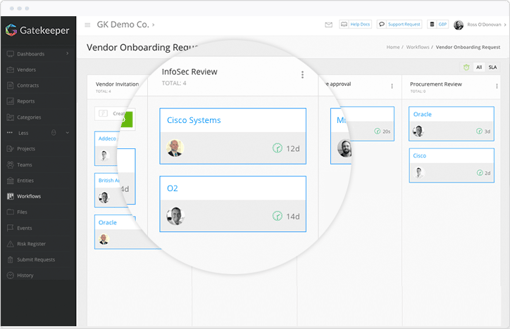 Automate your vendor onboarding with Gatekeeper
Automate your vendor onboarding with Gatekeeper
2. Store vendor information in a cloud-based, fully secure central repository
Gatekeeper vendor management software is built around a central repository, which gives you a secure and centralised place to store your vendor agreements, key dates, certificates and communication records.
When combined with tactical automation, this repository is elevated from a simple storage location to a strategic tool for your sustainable procurement processes.
A central repository – when powered by automation – helps you to improve governance by creating a single source of truth. Knowing where all of your vendor information is kept, as well as seeing a complete trail of any changes and updates made to their documentation, will help your business to be audit-ready and compliant at all times.
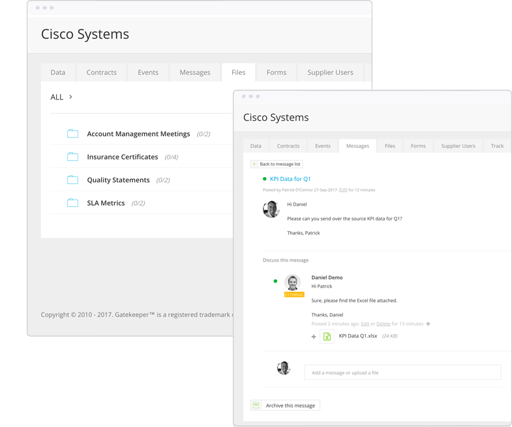 See everything in one place with Gatekeeper's contract repository
See everything in one place with Gatekeeper's contract repository
3. Trigger alerts and workflows to maintain compliance
Take control and act ahead of time with notifications based on key dates. Set notifications for upcoming expiry dates for sustainability certificates, for example, so that you can notify your vendors through a dedicated Vendor Portal of any actions required so they can provide you with an up-to-date version.
If the expiry date passes without any input from your vendors, you can take remedial action by coordinating and triggering a risk mitigation strategy, as well as raising and managing escalations. Vendor management software makes tracking your sustainable vendors completely seamless.
Alerts and workflows can also help you to stay ahead of your own workload. You can plan annual reviews of vendor compliance and be alerted to the ahead of time, allowing you to create an accurate picture of current statuses and any potential risks that could result in fines or disruption to your business.
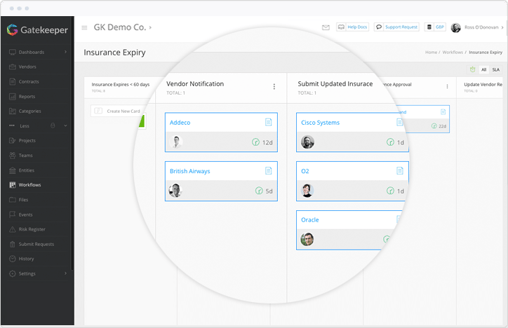 Visualise compliance and trigger related workflows.
Visualise compliance and trigger related workflows.
4. Create customised reports to support your sustainability objectives
Vendor management software helps to drive maximum value and performance from your vendors by checking if they are adhering to their targets. With customisable reports and Balanced Scorecards, you can collect and measure data to build an accurate view of your vendors’ performance against the agreed sustainability KPIs.
Visualising performance data means that you can easily compare the performance of each vendor, identify risks and gaps in your vendor base and make informed, strategic decisions based on accurate information.
Depending on performance results and your vendors’ responses to poor performance, you can create plans to achieve a far more sustainable vendor pool - whether that’s by terminating non-compliant vendors or procuring goods from vendors who more closely align with your goals.
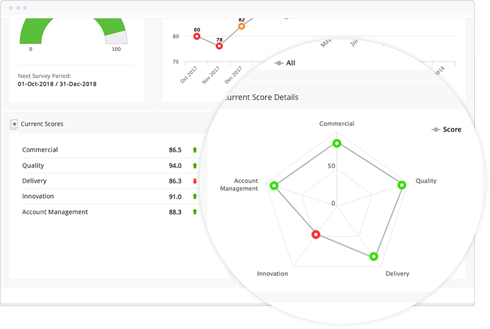 Compare vendor sustainability and performance with Balanced Scorecards
Compare vendor sustainability and performance with Balanced Scorecards
5. Proactively manage vendor risk
With vendor management software, your risk management strategies can be proactive rather than reactive.
With a dedicated Risk Module, you can analyse your risk landscape - categorising risks by supplier, type and category for example. This makes it easier to identify your sustainable suppliers if your vendor base currently has a mix of new and old relationships.
To create an effective risk strategy, you should assess the probability of non-compliance happening and outline the impact it could have:
- What consequences will your business face?
- What fines are associated with non-compliance?
- What disruption will be caused to the supply chain?
Based on the results above, you should give each vendor a score. Certain Risk Scores can trigger mitigation and escalation workflows, so remedial action is driven straightaway.
Another option is to assign a RAG Status to your sustainable suppliers, based on their current level of risk, These configurable reports allow you to assign the colours Red, Amber or Green across their accounts so you can make instances of, or the potential for, non-compliance clearly visible to the team.
Those that are marked red are the vendors that require most focus so your business can still hit its sustainability targets.
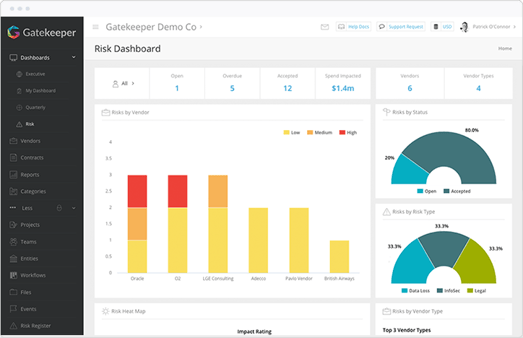 Gatekeeper's Risk Dashboard
Gatekeeper's Risk Dashboard
Wrap Up
Sustainable procurement best practices rely on the combination of commitment from your people, standardised internal processes and vendor management software that can help you to keep your vendor base accountable.
As economies try to recover from COVID-19, countries try to fight the climate crisis and organisations place more focus on inclusive opportunities, sustainable procurement will continue to be a required - rather than best - practice.
If you’re ready to get ahead of the curve, introduce sustainable procurement practices to your business or just want to know more about how vendor management software can support you, book a demo or get in touch today.

.png)
.png)
.png)
-4.png)